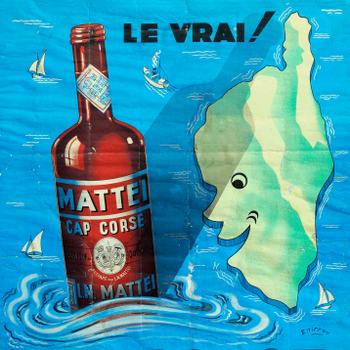 Cap corse rouge
Cap corse rouge
Cap Corse Rouge is among the most famous of French Quinquina, enjoyed for generations by visitors to and residents of the Island of Corsica. It is composed of a variety of local and exotic spices, walnuts, and cinchona bark on a base of Corsican Muscat and Vermentinu mistelles. The result is an aperitif of tremendous depth with a wonderfully dry finish. Traditionally served neat or on ice with tonic or soda. It mixes well with rye whiskey, apple brandy, or brandy.
Since its creation in 1872 by Louis-Napoléon Mattei, Cap Corse Mattei is the oldest and best-known aperitif of Corsica. Still today family-owned, and all macerations, aging, and bottling are done in-house.
Mattei is still today family-owned, and all macerations, aging, and bottling are done in-house. Cap Corse Rouge is traditionally served neat or on ice with tonic or soda, garnished with citrus peel. It mixes well with rye whiskey, especially so in a Boulevardier.
In 1872, a merchant named Louis-Napoléon Mattei named his aperitif wine after his native Cap Corse, a peninsula of Corsica that juts northward into the Mediterranean. A territory of France, Corsica has over the centuries been influenced by both France and Italy, as well as northern Africa. Mattei discovered the beneficial properties of cinchona tree bark during a voyage to the Caribbean, and he brought it to Cap Corse to blend with local wine. He added spices that made their way through Cap Corse’s bustling port, as well as Cedrat (citron), a thick-peeled ancestor of lemon. Cap Corse Mattei Quinquina was soon exported across the globe.
About Chinchona/Quinine The beneficial properties of the cinchona tree were originally discovered by the Quechua, a people indigenous to Peru and Bolivia, who found it an effective muscle relaxant to calm shivering due to low temperatures. The Quechua would mix the ground bark of cinchona trees with sweetened water to offset the bark’s bitter taste, thus producing tonic water. Jesuit missionaries in the early 1600s brought this back to Rome, where quinine in unextracted form came into use to treat malaria, which was endemic to the swamps and marshes surrounding the city of Rome and responsible for the deaths of several popes, many cardinals, and countless common Roman citizens.
Quinine was isolated and named in 1820 by French researchers, the name is derived from the original Quechua (Inca) word for the cinchona tree bark, quina or quina-quina, which means “bark of bark” or “holy bark”.
Large-scale use of quinine as a malaria preventative started around 1850, consumed in tonics or aperitif wines such as these. With other spices and wines selected to balance, many of these quinine aperitif wines became famous and sought out first as delicious and refreshing aperitif drinks.
Cocktail Recipes
Boulevardier
Stir with ice:
1 oz Cap Corse Rouge
1 oz Red Bitter Aperitivo, like Cappelletti or Campari
1 oz rye whiskey
Strain into double rocks glass filled with ice.
Garnish with an orange peel.
Core Reviver
Shake with ice:
0.75 oz Blended Scotch
0.75 oz Cap Corse Rouge
0.75 oz Peach Liqueur
0.75 oz lemon juice
Strain into a coupe. Garnish with a cherry.
Sentier en Bastia
Stir with ice:
1 oz rye whiskey
1 oz Cap Corse Rouge
1 oz Sweet Vermouth
Strain into an ice-filled double rocks glass.
Garnish with an orange peel.


